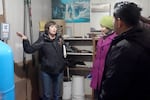It’s been more than a year since Morrow County declared an emergency over nitrate contamination in the Lower Umatilla Basin. But residents are still learning that their water is unsafe to drink.
Gloria Muñoz, 19, said she had just heard about the Boardman area’s nitrate pollution earlier that day. Her Monday night audience included three Oregon state legislators and about 30 residents whose patience in the government’s ability to clean their drinking water was quickly waning.

Gloria Muñoz, right, shares her concerns about nitrate pollution at a community meeting at the Blue Mountain Community College campus in Boardman, Ore. on Nov. 27, 2023.
Antonio Sierra / OPB
Muñoz told the crowd in Spanish that she had just moved to Boardman a month ago but had only found out about nitrate pollution the day of the meeting. She worried that the message wasn’t getting through to youth.
“I’m someone who thinks a lot about my future,” Muñoz said through Zaira Sanchez, the Oregon Rural Action director of community organizing, who had to pause to wipe the tears from her eyes during her translation. “I feel bad for the folks who planned their future here. The opportunities that they planned for themselves have died on this land that they can no longer drink water from.”
Oregon Rural Action has spent the better part of a year inviting government officials from the Willamette Valley to Boardman. When prominent figures like U.S. Sen Jeff Merkley and Gov. Tina Kotek traveled to Morrow County last year, Oregon Rural Action was there to lead tours of the area and host community meetings.
The arrival of three representatives from the state Legislature’s BIPOC Caucus was just the latest iteration on that trend. The visit from three Portland area lawmakers brought the potential that they could influence policy that would lead to solutions for a decades-old problem.
BIPOC Caucus seeks environmental justice
State Rep. Annessa Hartman, D-Gladstone, is the vice chair of the House’s agriculture and water committee, but she said her interest in coming to Boardman was also personal.
The Haudenosaunee legislator said she grew up on an Indian reservation where as a girl, she collected water for her family from a tank outside her home.
“I know what it’s like to not have access to clean drinking water and for it to be a resource that’s not infinite,” she said.

State Rep. Khanh Pham, second from left, speaks at a community meeting on nitrate pollution as state Rep. Annessa Hartman, center, listens at the Blue Mountain Community College campus in Boardman, Ore. on Nov. 27, 2023.
Antonio Sierra / OPB
State Rep. Khanh Pham, D-Portland, said the BIPOC Caucus decided to send representatives to Eastern Oregon because environmental justice is a part of its mission. At more than 40%, Morrow County has the highest share of Latino residents in the state.
“We know that across the country, but definitely in this state, communities of color often bear a disproportionate burden of the impacts of pollution, particularly the health impacts,” she said. “When Oregon Rural Action and the community members here reached out to us to learn more, we really jumped at the opportunity to deepen our understanding.”
Nitrate pollution caused by fertilizer and wastewater used in farms and industrial operations has plagued communities in Morrow County for more than three decades. Residents outside incorporated cities draw their drinking water from private wells that often test far past the federal limit for nitrate levels. Overexposure to nitrates has been linked to illnesses like cancer and thyroid disease.
The legislators stopped short of recommending any specific policies or making specific promises. They said they were there to learn and to take their experience back to Salem for further discussion.
The districts belonging to all the members of the BIPOC Caucus are well over 100 miles away from Boardman and Eastern Oregon. And while the caucus is entirely comprised of Democrats, Republicans dominate most of the districts east of the Cascades.
Still, Ricki Ruiz, D-Gresham, said he thinks he can work with the Eastern Oregon delegation should the need arise.
The BIPOC Caucus can engage with the local delegation here, whether it’s local legislators, county commissioners, or council people, he said. “Whether we agree or disagree, I think it’s gonna be a conversation we’re going to have in the future.”
Local legislators respond
State Rep. Greg Smith, R-Heppner, said he would have been in Boardman shaking his colleagues’ hands if he didn’t have a scheduling conflict.
Smith has long had close relationships with local businesses and industry, but he agreed with his Democratic counterparts.
“No one can or should defend unsafe drinking water,” he said.
He was less charitable to Oregon Rural Action. He estimated that “99.9%” of Morrow and Umatilla County had never heard of the La Grande nonprofit before it began its anti-nitrate pollution advocacy. And their work was hindering the effort to find solutions rather than helping it, he said.

Oregon Rural Action organizer Nella Parks talks about a well contaminated with nitrates with members of the Legislature's BIPOC Caucus near Boardman, Ore., on Nov. 27, 2023.
Antonio Sierra / OPB
“The folks who are responsible for putting nitrates in the ground, really want to have a conversation with the folks who have been impacted,” he said. “But they feel as if there’s this entity in between them that is making that challenging because of rhetoric.”
While the community audience expressed frustration with the state’s response to the crisis, Smith and state Sen. Bill Hansell, R-Athena, defended the state’s efforts to test wells and provide drinking water.
Smith did admit a long-term solution is still needed. Although the Port of Morrow has drawn scrutiny over its wastewater practices, the port only comprises a small percentage of total nitrate pollution. If Oregon wanted cleaner groundwater for the region, Smith said, it would need to address the irrigated farms, dairies and feedlots that pollute the most.
Whatever resolution is reached will involve more nitrate monitoring requirements, Smith said. Beyond that, how much more stringent a new nitrate policy would be is dependent on how much farmers cooperate.
“The question is, are those in agriculture going to be part of that solution and help bring technology and innovation to the table to make that occur?” he said. “Or is it going to happen to them.”
‘No more dog and pony’
When he appeared before Kotek in Boardman in August, Paulo Lopez Jr. was too overcome by emotion to get his message out as the governor promised “a new day” in the state’s response to the crisis.
Three months later, the 13-year-old tried again in front of Hartman, Pham and Ruiz.
“The governor did not just promise me, she promised all of us,” he said, his voice wavering. “She has barely done anything. I would just like you to remind the governor about her promise. It’s just not about our future, it’s about the future of the next generation and the generations coming on.”
Paulo’s frustrations were one of many shared at the meeting.
While Kotek and the Legislature have delivered funding for bottled water deliveries and well testing, there are gaps in service. Sometimes the deliveries don’t provide enough water for their families or the results of the well tests took too long to process, the residents said. While the state promised further testing and studies into the link between nitrates and illness, audience members didn’t consider them useful initiatives if nitrate levels were continuing to rise and residents were still getting sick.
The most frequent complaint was that the state still hadn’t done enough to prevent additional nitrate pollution.
“No more dog and pony,” resident Jim Klipfel said. “Just the show.”
Ruiz offered an apology to the lawmakers that he later translated to Spanish himself.
“We are going to hopefully make this not the first or last visit,” he said. “Hopefully, we get to come back, get to talk to more community members, get to listen to more testimonies, and go back to the Legislature and really figure out how we can best come up with a solution that makes sense for all of you.”
Lawmakers could get another crack at that solution during the next legislative session, which starts Feb. 5.